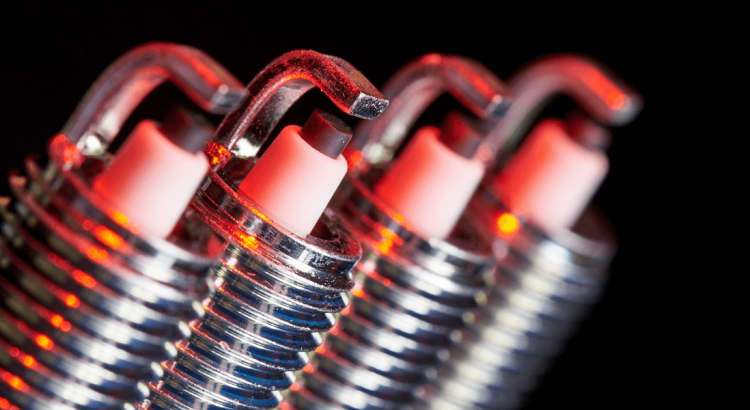Spark Plugs: What they are and how to test them

Spark Plugs: What they are and how to test them
Spark plugs are sensitive components in vehicles that have done many kilometres and require some care.
If you’ve ever wondered what spark plugs are, how to test them, and when to change them but never found the answers to your questions, you’re in the right place. Keep reading!
What is a spark plug?
A spark plug is responsible for providing the ignition spark to ignite the fuel inside the combustion chamber, causing the piston to move and therefore a car to pull out.
What is the purpose of a spark plug?
The main function of a spark plug is to create a spark inside the combustion chamber of a car engine so that it reacts with the mixture of fuel and air.
After this combustion, the pistons are pushed down, starting the engine.
What types of spark plugs are there?
There are 5 types of spark plugs:
- Copper Spark Plugs:
- Iridium spark plugs;
- Single platinum spark plugs;
- Double platinum spark plugs;
- Silver Spark Plugs.
Keep reading to find out how long spark plugs can last, when you should inspect yours, and how to replace them.
When should I check my spark plug?
Spark plug inspections are recommended to inspect the spark plugs every 10 000 km.
When should you replace your spark plugs?
Replacement periods may vary from car to car but should generally not exceed 40/50,000 km. If your spark plug has short fused before this period, you should replace it as soon as possible.
You can find more precise information on when to change your vehicle’s spark plugs in your car owner’s manual.
Spark plug service depends not only on the quality and type of fuel used but also on the car operating conditions.
Why do spark plugs wear out?
The amount of heat a spark plug can withstand is one of the most important characteristics to pay attention to, given that the pressure and temperature conditions under which spark plugs must operate are very demanding.
Replacing spark plugs in a timely manner avoids wear on other parts of the vehicle.
The next point will tell you all the tell-tale symptoms that you need to replace your spark plugs.
Which symptoms indicate that a vehicle’s spark plugs need to be replaced?
You must replace your spark plugs if you notice any of the following symptoms of wear:
- Loss of power;
- Increased petrol consumption;
- Difficulties starting your car;
- Dark smoke exiting your car’s exhaust pipe;
- Strange noises;
- The engine warning light comes on;
- Possible electronic malfunction – in your car radio or satnav.
Therefore, understanding how to ensure the upkeep of your spark plugs is a way of ensuring your car keeps running well.
Can you replace your car’s spark plugs yourself?
Yes, you can replace spark plugs yourself as long as you have the right tools to do so.
If you do not feel comfortable replacing your car’s spark plug kit yourself, you can always go to a manufacturer-approved garage or a reliable mechanic.
To learn more about the tools required by a mechanic, check out our article 11 Auto tools that all mechanic needs.

How can you test your spark plugs?
To test your spark plugs, follow these 5 steps:
1. Remove and inspect the wires
Working in a well-lit area, remove and inspect your car’s spark plug wires one at a time.
Wipe all the wires with a cloth and look for burn marks and cuts on the wires or terminals (spark plug wire ends).
For more information on inspection lamps, check out our article LED Flashlight: A must in your workshop.
Ensure that the metal clips at the ends of the wires are clean, in good condition and free from corrosion.
Carefully examine each wire’s insulation and look for signs of corrosion on the terminals, spark plugs, and ignition coils.
If no damage is detected, replace the wire and proceed to the next step.
2. Start your car engine
Turn on your car engine and listen out for sounds of a high-voltage electrical leak.
Be as careful as possible not to touch the wires while your car engine is running.
Doing so will put you at risk of an electric shock.
3. Perform a spark plug wire resistance test
Use a digital multimeter to check that the resistance of all spark plug wires is within the intervals determined by the manufacturer.
Remember to test each of the wires and reconnect them before moving on to the next wire.
If the reading is within the guidelines set by the manufacturer, you can put the wire back into the car. Any defective wires must be replaced.
4. Check the direction of spark plug wires
Cross-threading spark plug wires can create a power leak that reduces car performance.
To find out more about your car battery, check out our article Auto Battery: How to change them and which one to choose.
5. Replace the wires
Install the spark plug wires in the position they were in when you removed them, making sure that both ends are connected.
How much do spark plugs cost?
Prices of spark plugs range from 5 to 30 euros, depending on the engine type in your vehicle.
Interested in finding out more about the world of all things cars? Then follow us on Facebook and keep up with our daily content.
![]()






